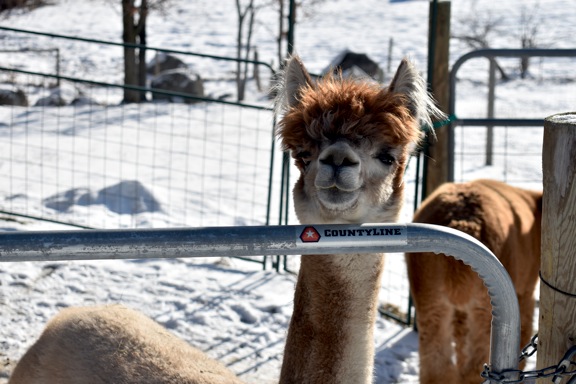SAVOR THE SEASON: Alpaca fleece makes cozy clothing

An alpaca at Jay Mountain Alpacas in Jay (News photo — Griffin Kelly)
JAY – The Alpaca Shoppe in this hamlet doubles as the Rosenblum Chiropractic office.
About 15 years ago, Seth and Trudy Rosenblum stumbled upon a craft fair in Saratoga. One of the vendors featured alpacas. When the couple got closer, an alpaca kissed Seth.
“That was the end of it,” Trudy said. They had to invest in some of their own.
Seth and Trudy soon contacted Patty Coolidge of Jay Mountain Alpacas and bought three of the animals from her. Coolidge not only provided the Rosenblums’ first llamas, but she also works at the store. Now, as well as being a place for back adjustments and natural pain relievers, the business offers a variety of sweaters, socks, hats and yarns all made from alpaca fleece.
Alpacas have been traditionally raised in the South American nation of Peru, where there are 4 million of the animals. Coolidge said things are different in a place like northern New York.
“Sometimes, the elements are what you battle more than the animal,” she said. “When it’s 10 below outside, it’s harder. But for the most part, the alpacas require food twice a day. We make sure their hay feeders are filled twice a day. They get grain once a day. They also get a mineral supplement that’s free choice so they can eat it whenever they want. They only get sheared once a year, unlike a cow that you need to milk every day. Aside from giving them food every day, that’s about all an alpaca really needs to sustain.”
Alpacas can easily be confused with another animal in the Camelidae family – the llama. They may look similar, but there are some noticeable differences. Firstly, alpacas are smaller, normally weighing about 150 pounds while the biggest llamas can reach 400 pounds. Alpacas are bred for their fleece and sometimes meat, while llamas were mainly used as pack animals, kind of like horses or camels but people didn’t ride on their packs. A big difference between the two animals is the hair. Alpacas have a much finer fleece that can be used for clothing whereas llamas do not.
There are many positives to alpaca fleece. It’s warm, it’s hypoallergenic and it’s incredibly soft. Many of the items in the shop are a blend of alpaca and other materials, but the ones that are 100 percent alpaca feel beyond comfortable.
“Alpaca doesn’t have that prickle factor that some people are opposed to in wool,” Coolidge said. “That being said, not all alpaca is created equal.”
She pointed to a rug hanging on the wall in the shop. It was imported from South America and had multiple sections of different colored fleece.
“Each one of those colors feels different, not because of the color,” Coolidge continued, “but because of the age of that animal, the nutrition that it received, the genetics of that animal. Those things all play a role.”
Coolidge said the Alpaca Shoppe gets more popular every year, and alpaca socks are normally the big seller.
“Socks. I don’t even have to think about,” she said. “They’re warm, and people love them. There’s been a lot of improvements to the socks over the past 12 years. They’re warm, but now there are so many more styles and varieties of them that there’s something that fits everybody’s need. Even if you want to wear them with a sneaker in the summer, we’ve got alpaca socks for that. Or if you want to wear them out when you are going skiing, we’ve got those, too.”
Trudy said the socks tend to wear out quickly just because people use them so often, but alpaca sweaters can last for generations if cared for properly.
Over at Jay Mountain Alpacas, a pack of long-necked ungulates crowded around the fence. They wanted to say hi to Coolidge. After a few moments of formalities, many of them went back to their food or lay down, but one alpaca named Pearl, who had a heavenly white coat, stayed. Coolidge petted her face and said “good girl.”






